
Avoiding Mob Violence
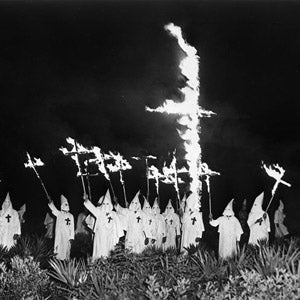
Perceived injustice has sparked protests around the globe. In some cases these gatherings are peaceful, and in others they turn into a violent mob. Lately we’ve seen a list of pundits on both sides of the arguments saying the violence is racially driven, which is simply not supported by the facts. Mob Violence is not an “African American” phenomenon and we have seen violence erupt in New York at 2011’s Occupy Wall Street movement that certainly crossed racial lines. Other cultures and countries are not immune. Tahrir Square in Egypt, Paris and Sarcelles France, Jerusalem in Israel and the Palestinian territory and throughout Iran in the past few years. There is not a race or country on the earth that has not been effected at some point…
When we look at the phenomena of group violence there are a number of theories that play into how large group activities lend themselves to sponsoring violent behavior. This phenomenon has actually been studied extensively in the fields of psychology, sociology and ecology. We are going to take a cursory look at three elements of these theories and attempt to provide an understanding of how these things impact your the chances of surviving a violent mob and provide you some ideas on how to improve your chances.
Someone else is dealing with the problem – Diffusion of Responsibility.
 The first and most relevant studies on diffusion of responsibility were sparked by the rape and murder of Catherine Genovese in 1964. She was stalked, stabbed, screamed for help waited an estimated ten minutes while crawling to a vestibule at her apartment door while begging for assistance before the assailant returned and raped and stabbed to her death. After approximately 30 minutes, only one of the thirty-eight people who reportedly had heard her pleading for help, or heard some element of the event called the police. Every one of them assumed someone else had already done so.
The first and most relevant studies on diffusion of responsibility were sparked by the rape and murder of Catherine Genovese in 1964. She was stalked, stabbed, screamed for help waited an estimated ten minutes while crawling to a vestibule at her apartment door while begging for assistance before the assailant returned and raped and stabbed to her death. After approximately 30 minutes, only one of the thirty-eight people who reportedly had heard her pleading for help, or heard some element of the event called the police. Every one of them assumed someone else had already done so.
Signaling (or quality of the identifier of non-conforming behavior) further plays an important role in diffusion of responsibility, especially in protests. If there is any room to assume behavior that is outside the group norm was a mistake, that is what an individual will do and they will consistently choose to ignore it. In a group of people shaking their fist, identifying a punch becomes difficult, and even standing feet away from it; people will ignore a violent outburst if there is anyway for them to do so.
Clear goals, means and limits play an important role in the onset of violence. When organizers are clear about the message and the acceptable means by which that message is communicated, the potential for violence is lower. Reginald Denny was pulled from his truck in 1992 during the Rodney King Riots. A number of protesters walked by and did nothing as he was beaten with a hammer, had a 500 pound medical device dropped on his head, a slab of concrete dropped on his head, and was kicked and punched repeatedly. Some protestors even participated by spitting on him and throwing bottles at him. They walked by as multiple assailants abused and attempted to end the life on an unconscious truck driver. Everyone of them certainly knew it was wrong, but had no metric or statement given to them that they could point to as say “This is not why we are here”.
Every one else is doing it… Groupthink.
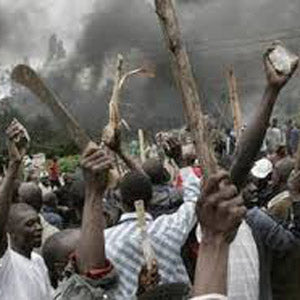 When we look at what occurred in Rwanda in 1994, we see members of a majority tribe pick up a machete and literally butcher their next-door neighbors. These are people who live and work in the same community. The bloodshed lasted over three months during which approximately 800,000 Tutsi were murdered by the Hutu majority along with a number of moderate Hutu’s. Nazi Germany, Cambodia, Croatia and what we are currently seeing from ISIS are examples of this phenomenon taken to the extreme.
When we look at what occurred in Rwanda in 1994, we see members of a majority tribe pick up a machete and literally butcher their next-door neighbors. These are people who live and work in the same community. The bloodshed lasted over three months during which approximately 800,000 Tutsi were murdered by the Hutu majority along with a number of moderate Hutu’s. Nazi Germany, Cambodia, Croatia and what we are currently seeing from ISIS are examples of this phenomenon taken to the extreme.
In study after study they have determined that once people join a group or a cause, they are very unlikely to criticize or differentiate themselves from the group. The degree of commitment plays into it, but simply evoking a statement of support for a cause will result in study participants actively ignoring contrary evidence and continuing to pursue what they know to be a flawed argument. At the point a person has shown up, is walking, marching, chanting and carrying signs, that person’s intuitive commitment to the cause has escalated at each step, and they are less likely to see or react to violence if and when it occurs.
I can get away with it – Group Anonymity
Frequently, what we deal with in mob violence is fairly isolated pockets of violence in the midst of large movements. While these isolated pockets are not the norm, the impact they have is exceptional. South African journalist Lara Logan was stripped and repeatedly reped over the course of being moved nearly a football field in distance, by multiple assailants through a densely packed crowd in Tahrir square – and many in the crowed had no idea that she and several other women were assaulted that night. The men responsible for these actions are not indicative the group, but the anonymity provided by the group provides an opportunity that these types of people can and do exploit. We call theses people agitators and they will find their way into the midst of any large event and attempt to use it for their own purposes.
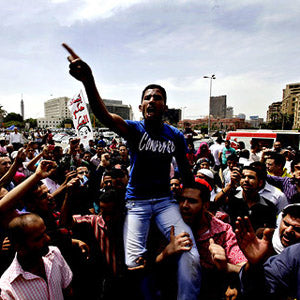 Group leadership such as community organizers typically have recruited people to their cause via some sort of a positive message. They additionally have the most to lose should socially inappropriate events occur during “their” event. The problem is that as the group expands beyond the physical control (meaning the ability to influence individual actions) of the group leaders, the group will identity and select a local influencer to follow. In that gap between legitimate group leadership and the fringes of the movement is where the agitators go to work.
Group leadership such as community organizers typically have recruited people to their cause via some sort of a positive message. They additionally have the most to lose should socially inappropriate events occur during “their” event. The problem is that as the group expands beyond the physical control (meaning the ability to influence individual actions) of the group leaders, the group will identity and select a local influencer to follow. In that gap between legitimate group leadership and the fringes of the movement is where the agitators go to work.
A Scapegoat emerges and violence ensues – Leadership and blame
 It boils down to marketing. Hitler talked about national pride, hard work, and building a better future – he did not build a movement by saying “lets go kill some Jews” (at least not initially). Ghandi discussed political representation and freedom from oppression, he did not say “lets go get hundreds of our country men beaten and killed by government forces”. Even ISIS is fighting to “build a Muslim society (Caliphate)” publicly, they do not advertise their cause by saying “we are slaughtering men, enslaving children and raping women – want to join?”
It boils down to marketing. Hitler talked about national pride, hard work, and building a better future – he did not build a movement by saying “lets go kill some Jews” (at least not initially). Ghandi discussed political representation and freedom from oppression, he did not say “lets go get hundreds of our country men beaten and killed by government forces”. Even ISIS is fighting to “build a Muslim society (Caliphate)” publicly, they do not advertise their cause by saying “we are slaughtering men, enslaving children and raping women – want to join?”
We can identify trends in movements that turn violent and those that do not and the most simple and easily identifiable characteristic is the naming of a scapegoat. The cause may be valid, but the minute a name is applied to a person, group or organization that is irresponsible for the injustice, be it a race, person or profession; that scapegoat is much more likely to suffer violence at the hands of the mob . The Jews, Hutu’s, currently the Yazidi’s and many other groups have been, and are being brutalized in large scale while otherwise good people stand by and do nothing.
Leaders or agitators creating scapegoats for their cause are inciting violence. In smaller scale movements we frequently see events more along the lines what occurred to Lara Logan, Reginald Denny, and Catherine Genovese where people were available, aware to some extent, and simply chose not to, or felt powerless to stop what they knew to be inappropriate conduct. At the point a committed group starts to turn violent all of the above social factors encourage members to ignore it, cover it up, or go with the flow and even participate. The repercussions for not doing so could quite possibly result in violence against the “deserter”. The impulse to act will rarely be as strong as the impulse toward self preservation.
What to do about it…
Understanding the causes of violence is useful but only if we can apply the information to reduce the risk of becoming a victim. At the point you are targeted by a mob you are most likely already a victim. Whether you accept that definition or not, you are now dependent on your physical skills to extricate yourself from this situation. Regardless of how physically talented you are, you are unlikely to deal with a mass of assailants effectively. The concept that you will fight your way to freedom and escape at the point you are attacked is a gross exaggeration of anyone’s ability, and a delusional expectation of how things will play out. The only effective means is to identify the indicators that violence is about to occur, and to remove your self from situation prior to being targeted.
Breaking down the likelihood of mob violence is matter of taking the time to look at the indicators and controls we have discussed in the preceding paragraphs and here are some considerations to look at when evaluating the risk of violence.
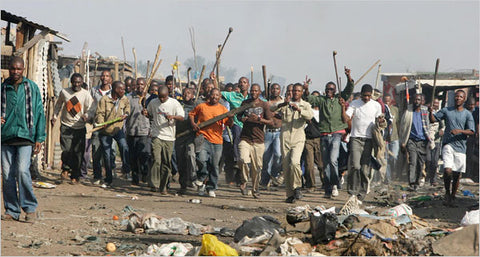
1) Is this a planned event? Have the organizers of the protest or gathering established protocols for the event to include concrete definitions of acceptable and unacceptable behavior on the part of participants? Are those readily available, easily understood and most importantly, non violent? If the answer to the any of these questions is “No” then the risk of violence is elevated.
2) Do you have personal relationships with people who will be attending? Will they come to your aid should things turn violent? We have seen that we cannot depend on the rest of society to assist when and if things do not work out. Attending a protest alone is a significant risk factor.
3) Are your fellow attendee’s physically capable of, and prepared to act to assist each other when and if violence breaks out? If so, do you have a plan to account for everyone in the group when and if departure becomes necessary? If the answer to the these questions is “No” then you are choosing to accept that the will of the mob will dictate your future and that is a significant risk.
4) Can you maintain a reasonable distance from or stay in proximity to the protest or event organizers? Since they have the most to lose from this event turning violent (assuming that is not the original intent), and they exert at least some measure of control; staying with their physical sphere of influence is an important influencer in your ability to stay safe.
5) Can you stay focused on actively looking for, and are you capable of identifying agitators? Most of the crowd will be focused on participating in the protest (Chanting, marching, shaking their fist, etc…). They largely move with the flow of the crowd under the assumption that everyone is there for the same reason, and that things are going according to plan. Three subgroups in the larger collection of people will not be along for the ride. The first is leadership who is likely to be focusing of keeping the masses focused on the cause and the goal of the movement. The second is agitators who are looking for pockets of people and individuals who they can segregate and turn to their own purposes. The third is people, hopefully like you, who are looking for signs of trouble. The commonality is that these three types of people are looking at the crowd, and are not as intently focused on participating in the event. They stand out like someone facing the wrong way in an elevator – if you are looking!
Everything was going great and then out of nowhere….
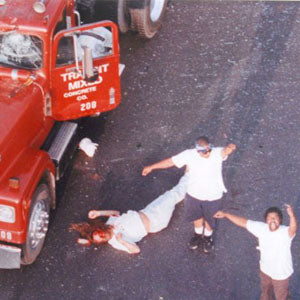 Chances are everything was not going great, and violence did not erupt out of nowhere, but crowds are fickle, and staying in contact with associates can be challenging. Perhaps you simply walked out of your office oblivious to the fact that there was a protest that evening, or perhaps they over took you driving to the convenience store. Anytime there is a protest, there is a chance someone like Reginald Denny will simply be in the wrong place at the wrong time.
Chances are everything was not going great, and violence did not erupt out of nowhere, but crowds are fickle, and staying in contact with associates can be challenging. Perhaps you simply walked out of your office oblivious to the fact that there was a protest that evening, or perhaps they over took you driving to the convenience store. Anytime there is a protest, there is a chance someone like Reginald Denny will simply be in the wrong place at the wrong time.
Should you find yourself in the midst of a protest that is turing violent, things are not completely hopeless.
1) First and foremost, your goal is now to blend in – enthusiastically if possible. That means shaking your fist, chanting and marching with the crowd or doing whatever they are doing. We are in this together, and you are part of their movement (regardless of how you personally feel about it). This is highly unlikely to have saved Reginald Denny, and sometimes violence is inevitable, but for the most part you have a window of opportunity to influence it.
2) Identify leadership and agitators as quickly as possible. If feasible, stay as close to leadership as you can and steer clear of agitators, unless there is a clear and open path away from the crowd and the mob in general.
3) Personally introduce yourself and express your enthusiasm for the cause to those around you. You may not know anyone, but once they know your name, they will feel some level of obligation to assist you, should the mob turn it’s anger on you. The more people in your immediate vicinity with whom you can remove the anonymity and build even a superficial connection – the better.
4) Flow downstream with the current and move at their pace. When you move, move laterally to increase distance between yourself and any perceived threats. Moving against the current is likely to anger participants, makes you stand out and may even get you branded as a deserter or worse.
5) Identify areas on the outskirts of the crowd that provide an opportunity for you extricate yourself from the crowd. Cross streets, open areas, an open business, etc. Agitators will hang out on the fringes so be sure there is little chance of violence in that area before separating yourself from the leadership and moving out of the area.
6) You are at the greatest risk of being attacked as an outsider the minute you physically separate your self from the mob. At the point you break away, move decisively to create as much space and distance as possible.
7) Don’t expect or rely on police assistance. Typically, protests are against the government and some perceived transgression. The most likely focus of any aggression is the police 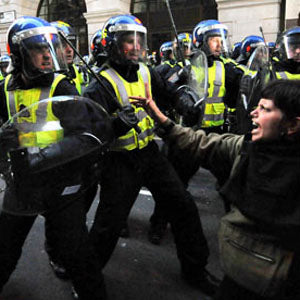 and security forces. Being near them increases the chances of you being caught up in the melee and when violence occurs police and security forces will first close ranks and defend themselves. Next they will identify agitators and attempt to segregate them from the crowd. This typically involves penetrating into the mob with shields and baton’s and dragging the agitator to a secure location. They are very unlikely at that point to be able to differentiate between innocent bystanders and attackers when being struck with objects or having Molotov cocktails hurled in their direction. When things are turning south, being in the vicinity of police is a significant risk factor.
and security forces. Being near them increases the chances of you being caught up in the melee and when violence occurs police and security forces will first close ranks and defend themselves. Next they will identify agitators and attempt to segregate them from the crowd. This typically involves penetrating into the mob with shields and baton’s and dragging the agitator to a secure location. They are very unlikely at that point to be able to differentiate between innocent bystanders and attackers when being struck with objects or having Molotov cocktails hurled in their direction. When things are turning south, being in the vicinity of police is a significant risk factor.
The goal is not to be noticed while you assess the situation and make an executable and definitive plan to get yourself out of the situation – hopefully without putting yourself in a worse situation.
Think ahead, do some research and have a plan to stay safe.
~ Patrick Henry
Leave a comment
Comments will be approved before showing up.
Also in Staff Articles

Home Defense - What you can do...

Gun Review: Sig Sauer P938
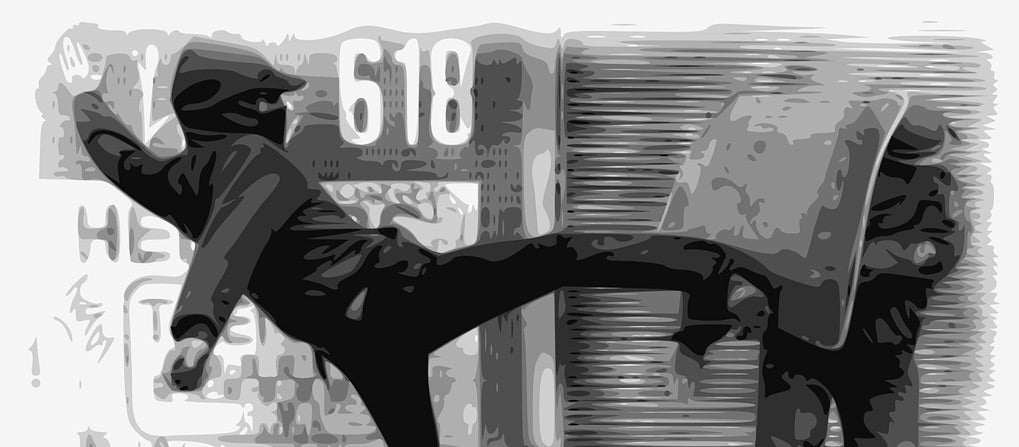

Patrick Henry
Author